Known in Thailand as tod mun pla, Thai fish cakes pack a serious flavour punch. Commonly served as street food in Thailand, they’ve become very popular the world over for good reason.
- Loaded with flavour from fish sauce, onions and curry paste.
- So easy to make – ready in under 30 minutes
- The perfect soft, almost spongy texture
- Affordable – so much cheaper than your local restaurant.
- Great for an appetizer or party finger food or turn them into dinner.
Not only are these just as good or maybe even better than your local Thai restaurant, you get way more for your money. The perfect umami bite, dipped in a tangy and sweet, Thai cucumber relish, you’ll never want to buy them again.
Want to create a Thai banquet at home? Serve up some Thai chicken satay too, then follow up with a light dinner of lime coconut chicken.
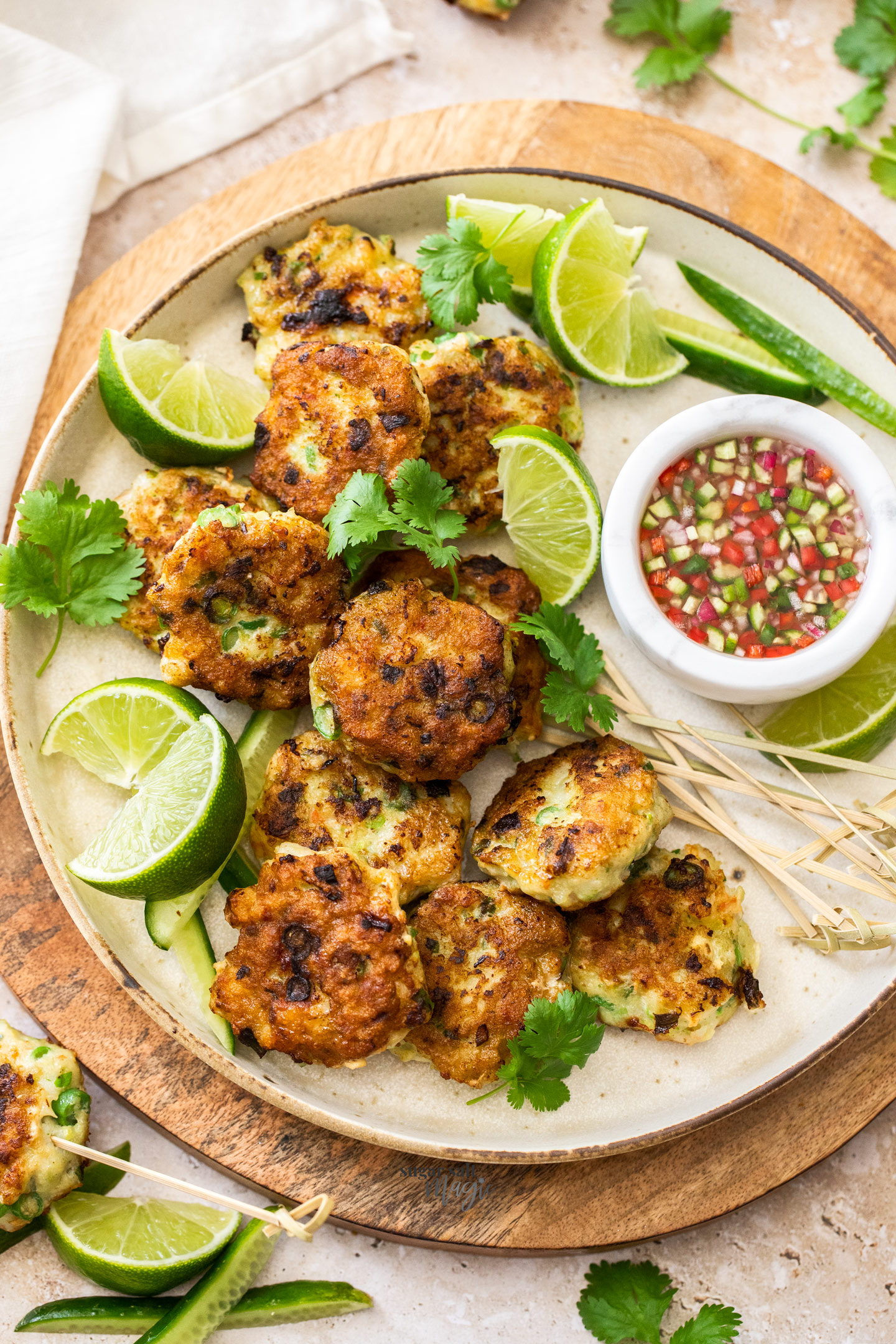
Never Miss a Recipe!
Get the latest recipes straight to your inbox!
What are Thai fish cakes?
Traditional Thai fish cakes have a kind of spongy but tender texture. They are classic Thai street food, normally served with a little skewer to pick them up and a cucumber sauce (called ajaad).
They are flavour packed with classic Thai ingredients – fish, fish sauce, spring onions, lime, green beans (they add some crunch) and curry paste. Normally, red curry paste is used but I love the freshness that green curry paste adds and use my own in this recipe. I also combine prawns and fish making these somewhere between a Thai fish cake and Thai prawn cakes.
Ingredients you’ll need
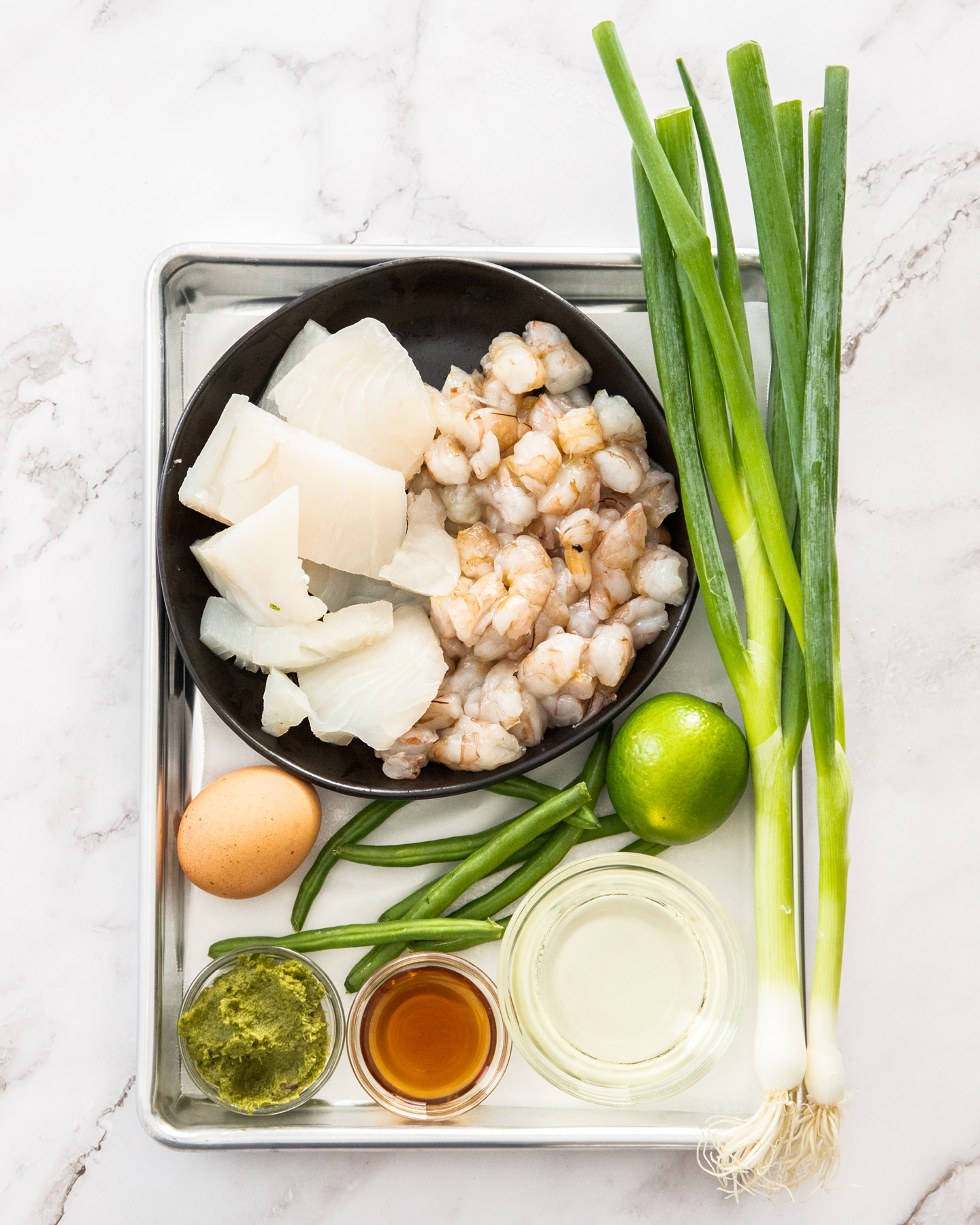
Detailed quantities and instructions in the recipe card below.
- Fish: Use a nice white fish here – try snapper, basa, ling, dory, cobbler, hoki or perch. Steer clear of very firm fish like swordfish or shark or oily fish like sardines and mackerel.
- Prawns: While I love the addition of prawns, it’s not traditional and you can feel free to use all fish instead.
- Curry paste: Traditionally, red curry paste is used but I love the freshness of green curry paste. Just choose your favourite.
- Spring onions: Also known as scallions or green onions, spring onions add just the right amount of onion flavour whilst also adding freshness.
- Fish sauce: You cannot skip the fish sauce.
- Lime adds tang and again adds freshness.
- Green beans are another must-have Thai fish cake ingredient. If you don’t love green beans, don’t worry, they don’t add flavour so much as they do crunch.
How to make Thai fish cakes (step-by-step)
These are so easy to make. All you need is 10 minutes and a food processor and you have the mixture ready for frying!
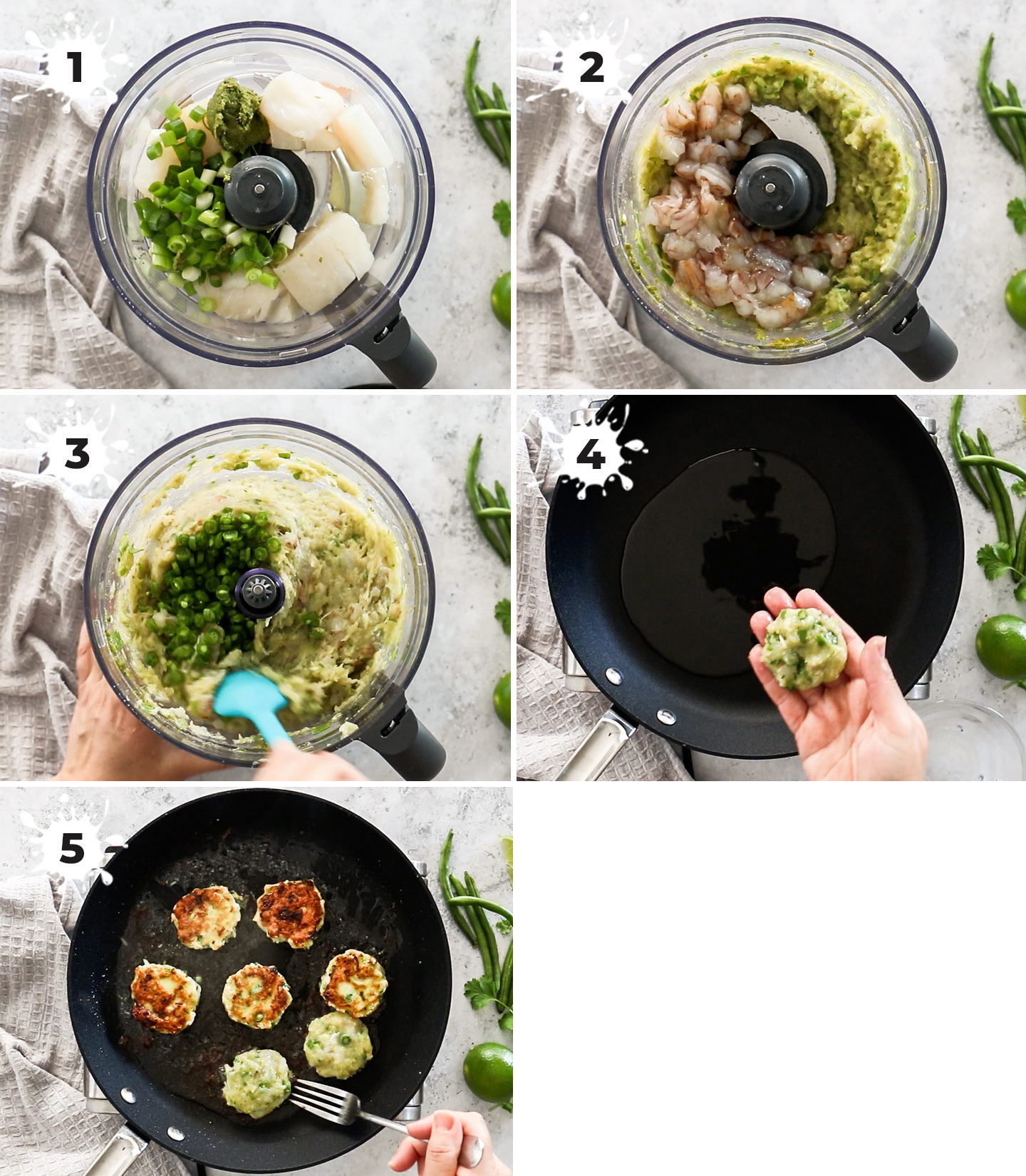
Detailed quantities and instructions in the recipe card below.
- Combine fish, spring onions, green curry paste, fish sauce, egg and lime zest to a food processor. Process just until there are a few chunks left.
- Add prawns and blitz until you like the texture – keep a few chunks or make it all smooth. I like a few small chunks of prawn left.
- Stir in green beans, then shape the mixture into small patties.
- Fry the patties until golden on each side.
Just 10 minutes and a food processor. So Easy!
Dipping sauce for Thai fish cakes
The classic Thai fish cakes dipping sauce is the same one often served with satay. I have created mine, based on my favourite Thai restaurants version that has tiny little cubes of cucumber, onion and chilli. It’s so good and I use this sauce on many things from chicken satay to spring rolls to my sesame prawn toasts.
You can also serve these with Thai nam jim sauce or Chinese sweet and sour sauce.
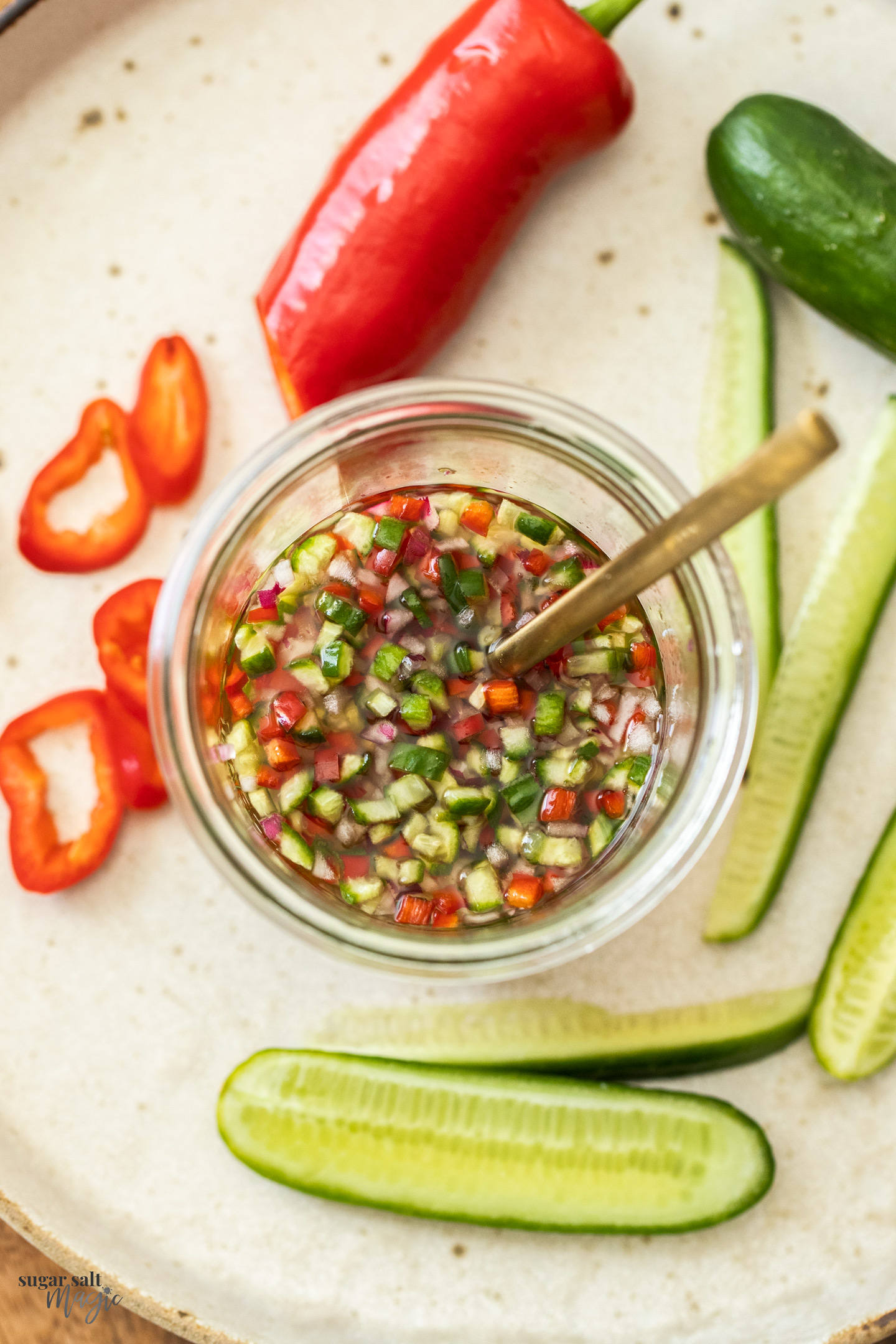
Detailed quantities and instructions in the recipe card below.
- Boil rice wine vinegar, sugar and water in a saucepan for 1 minute then let it cool completely.
- Stir in cucumber, onion, chilli and fish sauce.
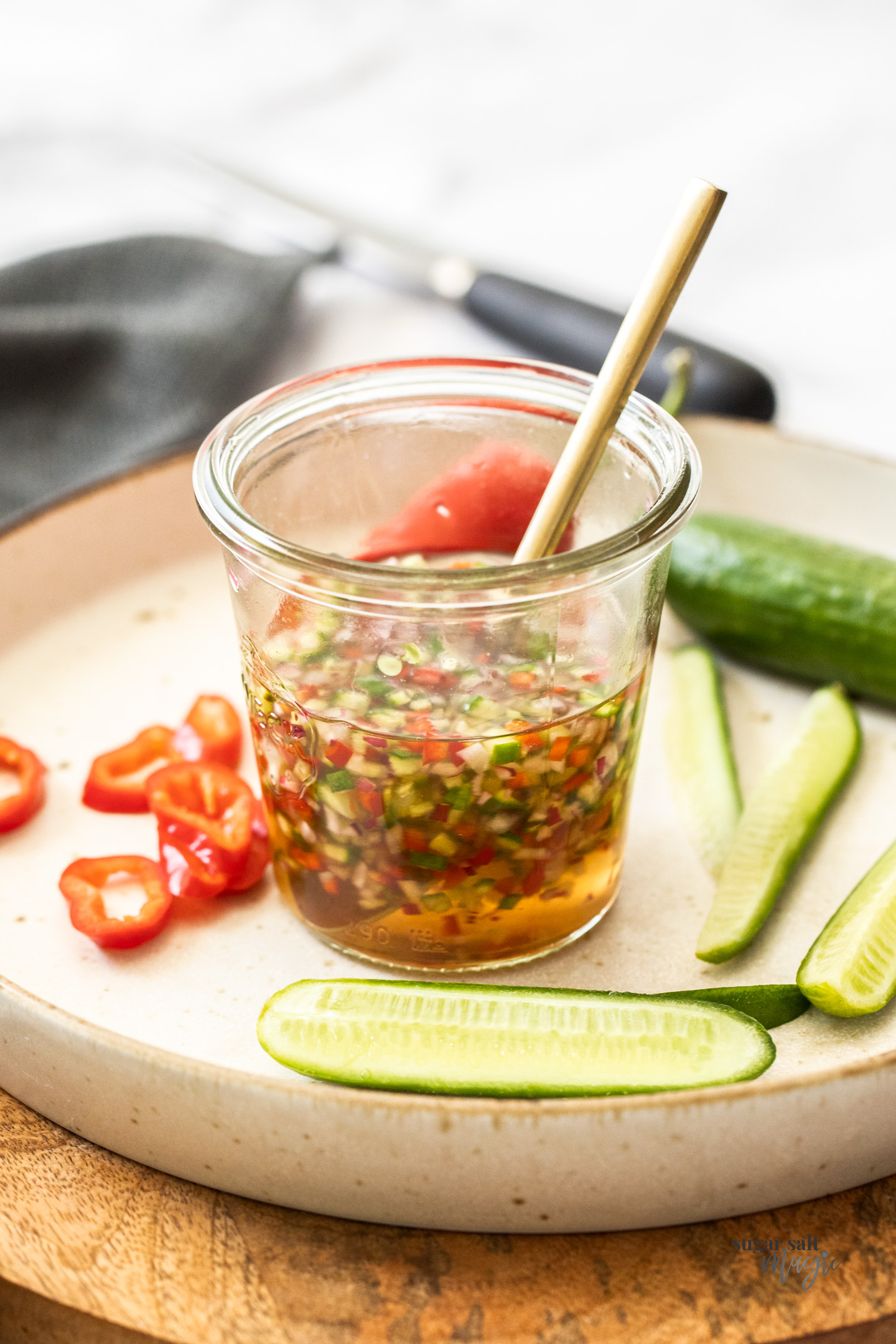
Tips and tricks
- Wet your hands when shaping the patties: This is a soft and sticky mixture so slightly wetting your hands stops it from sticking to you.
- Use a cookie scoop: If you have one, use a cookie scoop roughly 2 tablespoons in volume to scoop the fish cake mixture. This way they’ll all be the same size.
- Don’t overcrowd the pan: Fry the fish cakes in batches so that they don’t end up steaming instead of frying. They’ll stay warm on a plate, covered with foil.
- Make the sauce ahead: You can make this sauce ahead and it will happily sit in your fridge for days!
What to serve with Thai fish cakes
Thai fish cakes (tod mun pla) is normally served in restaurants as a starter or appetizer so it’s perfect for that or for party finger food, served simply with the Thai cucumber sauce.
Other ideas:
- Rice: Serve it simply with steamed rice or try my prawn fried rice.
- Salad: A simple salad of cucumber and julienned carrot is great with the bold fish cake flavours but Asian slaw is great too – crunchy and tangy.
- Noodles: Try it alongside pad Thai noodles or pad see ew.
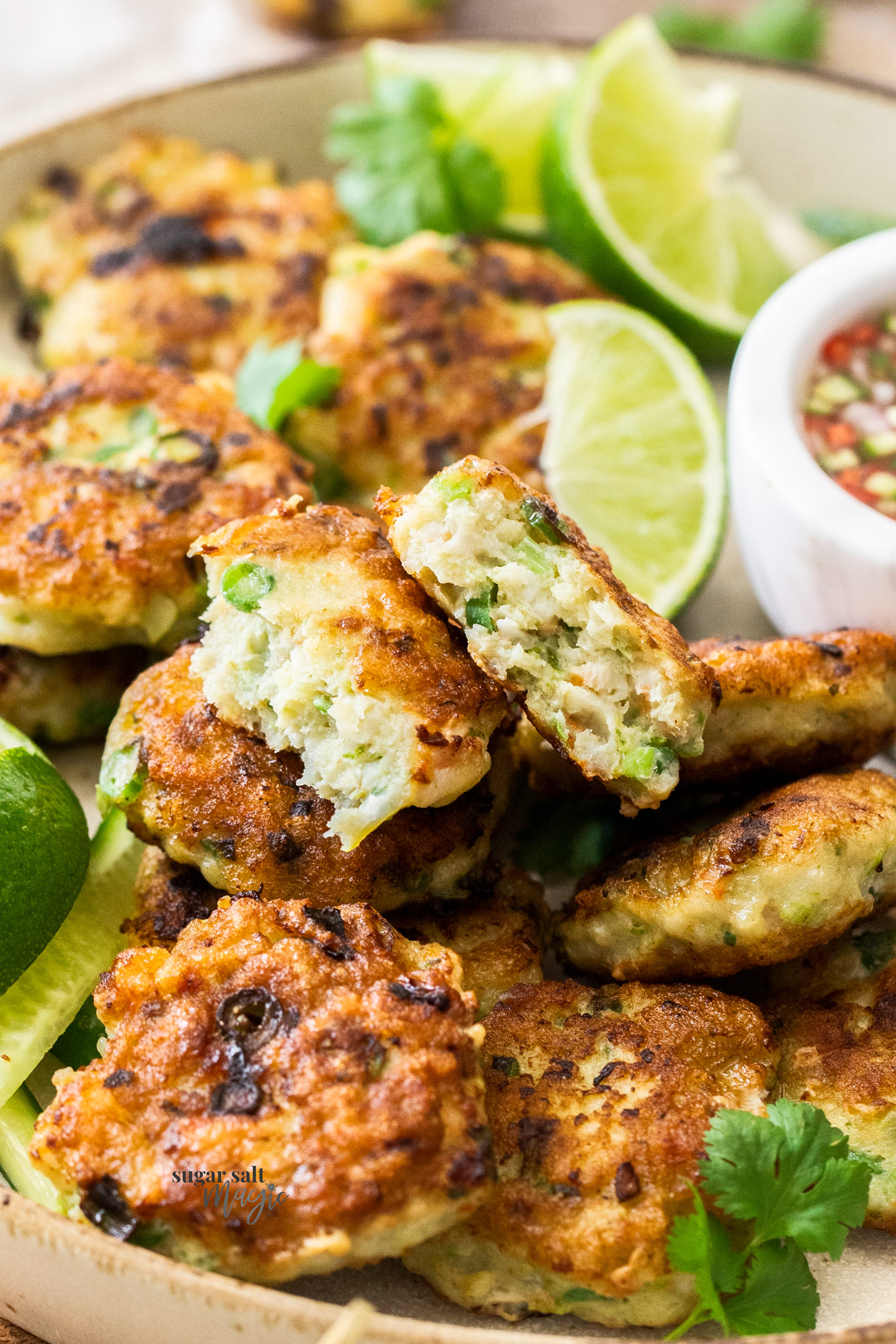
FAQs
When we’re talking about Thai fish cakes, a good all-round white fish is perfect.
Do use: Snapper, basa, ling, dory, cobbler, hoki or perch.
Don’t use: Very firm fish like swordfish or shark or oily fish like sardines and mackerel.
Authentic Thai fish cakes are made of fish, curry paste, egg, spring onions, lime zest, fish sauce and green beans.
Thai fish cakes can be reheated easily in the microwave for a minute or two (splash a little water over them first), back in a pan with a touch of oil or in the oven (180C / 350F for 10 minutes).
Yield and storage
- Storing leftovers: Store leftover fish cakes (you lucky thing) in an airtight container in the fridge for up to 3 days.
- Freezing instructions: Place into an airtight container in the freezer. They will keep up to 3 months.
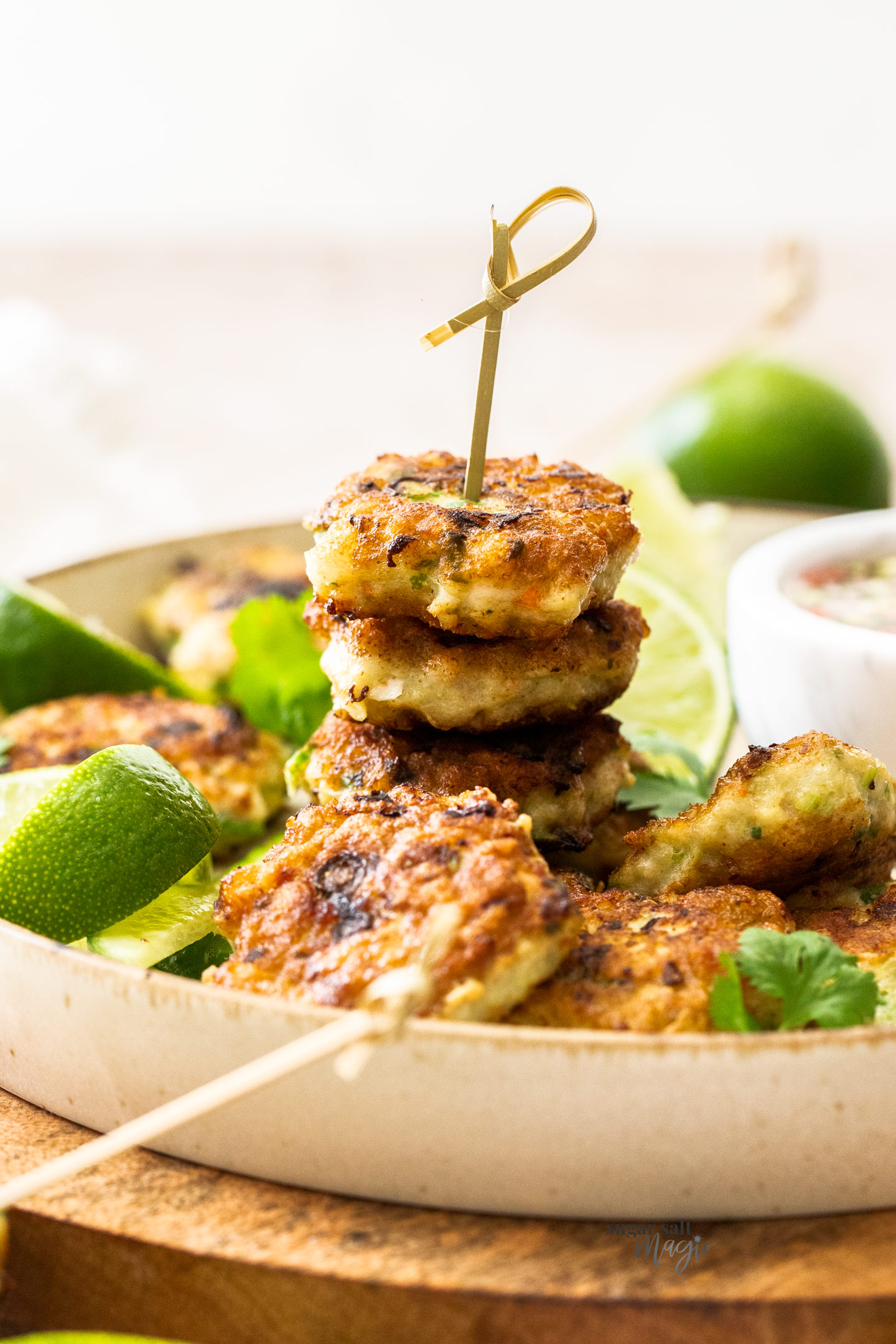
Did you try this Thai fish cakes recipe?
Leaving a rating and comment below the recipe is so helpful!
Hungry for more? Subscribe to the newsletter for free recipes straight to your inbox. Also, follow along on Facebook, Pinterest and Instagram.

Ingredients
THAI CUCUMBER SAUCE (AJAAD)
- ⅓ cup rice wine vinegar (80ml)
- ¼ cup white granulated sugar (50g / 1.8oz)
- 2 tablespoons water (40ml, notes 1)
- 2-3 teaspoons finely chopped fresh chilli, to your taste
- ¼ cup finely diced cucumber, seeds removed
- 1 tablespoon finely diced shallots (or red onion) (notes 1)
- ½ teaspoon fish sauce (or soy sauce if you don’t like fish sauce
THAI FISH CAKES (TOD MUN PLA)
- 250 g firm white fish fillets (like snapper, basa, tilapia) (8.8oz)
- 250 g raw prawn / shrimp meat (or more fish) (8.8oz) (notes 2)
- 2 spring onions (scallions / green onions) finely sliced
- 1 ½ tablespoons green curry paste (notes 1 & 3)
- 3 teaspoons fish sauce
- 1 large egg
- 1 lime
- 7 green beans, finely sliced into rounds
- ¼-⅓ cup peanut oil (or canola oil)
- Fresh coriander / cilantro, for garnish
For best results, always weigh ingredients where a weight is provided
Equipment
- food processor
- 2 Tbsp cookie scoop is helpful
- Frying pan or large skillet
Instructions
- FOR THE THAI CUCUMBER SAUCE:Heat rice wine vinegar, sugar and water stirring until dissolved. Bring it to a boil for a minute, then set it aside to cool.
- Once cool add chilli, cucumber and onion. Stir in fish sauce.
- FOR THE FISH CAKES:Peel and devein the prawns, then chop them into a few chunks. Set aside.
- Make sure the fish is free from bones, roughly chop and place it in the food processor.
- Add the spring onions, green curry paste, fish sauce and egg. to the food processor. Use a microplane to zest the lime and add the zest to the food processor too.
- Blend until just a few chunks remain.
- Add the chopped prawns and blend again until everything is quite fine with just some small chunks of prawn meat.
- Add the green beans and mix with a spatula to combine.
- Use wet hands to carefully roll and press 2 tablespoons of mixture into a disk about 5cm (2inch) wide.
- Heat half the oil in a non-stick frying pan or skillet over medium high heat. If your pan is not non-stick, you may need to double the oil to prevent them sticking.
- Add half the fish cakes and cook for 2 minutes or until you can see the line of cooked mixture about half way up the fish cake. Flip and cook another 2 minutes on the other side.
- Transfer to a plate lined with paper towel. Repeat with remaining oil and fish cakes.
- Cut the lime into wedges. Serve the fish cakes with the lime wedges (to squeeze over a little lime juice) and the Thai cucumber sauce on the side.
- Please take a moment to leave a comment & rating. It's appreciated and so helpful.
Notes
- Tablespoons: I use a standard Australian 20ml tablespoon (equal to 4 teaspoons) – check the volume of yours before measuring.
- Prawn meat: Weight shown is for meat only. If buying prawns in their shells you’ll need to buy at least twice as much.
- Curry paste: Traditionally, Thai red curry paste is used but I love the freshness of green curry paste. You can use whichever you prefer or have on hand. You can leave it out if you don’t want your fish cakes to be spicy.
- The Thai cucumber dip: If you don’t feel like making the sauce, a good store-bought Thai sweet chili sauce will do the trick.
- Consistency: You can blend the mixture until completely smooth if you prefer, but I love a few small chunky bits of prawn.
This post may contain affiliate links that earn me a small commission for my referral, at no extra cost to you. Thank you for supporting Sugar Salt Magic.




6 Comments on “Thai Fish Cakes”
Had a “taste” session for dinner party starters tonight. OMG. Wonderful. Absolute winner
Planning on making them the night before and heat up for minimum fuss
So, so happy you love them, Diane. These really are a great starter.
These were fantastic!! I followed the recipe exactly, except I used rainbow trout for the fish. I’ll definitely be making these all the time now!
Thanks so much for the recipe!
So happy you love them, Camille. Truly appreciate you dropping back to leave a review 🙂
Made these tonight for dinner. We loved them. Thanks Marie.
This makes my day, Pamaela. I’m so happy you loved them. Thanks so much for trying my recipe 🙂